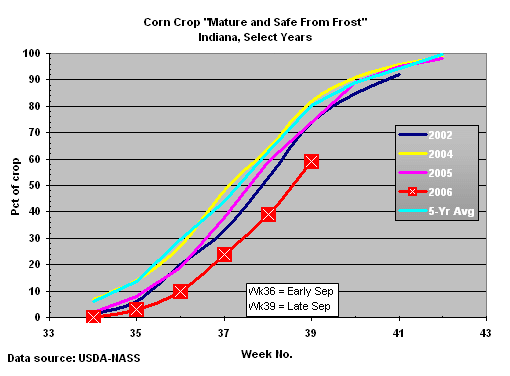

![]() orn
harvest is slow to get going this year, with only 5% of the state’s crop reported
harvested as of 24 Sep (USDA-NASS,
25 Sep 2006). The causes of the slow start to harvest are slower than normal
maturation of the grain (Fig 1), cool temperatures (slower grain drying), and
muddy field conditions due to the continuing pattern of frequent rains. The
slow pace of corn harvest coupled with the poor stalk quality in some fields
(Nielsen,
2006) reminds us how spoiled we were with generally good harvest conditions
of the past two seasons. But, that is not the point of this article.
orn
harvest is slow to get going this year, with only 5% of the state’s crop reported
harvested as of 24 Sep (USDA-NASS,
25 Sep 2006). The causes of the slow start to harvest are slower than normal
maturation of the grain (Fig 1), cool temperatures (slower grain drying), and
muddy field conditions due to the continuing pattern of frequent rains. The
slow pace of corn harvest coupled with the poor stalk quality in some fields
(Nielsen,
2006) reminds us how spoiled we were with generally good harvest conditions
of the past two seasons. But, that is not the point of this article.

Fig. 1. Percent of Indiana's corn crop that is rated "mature and safe from frost",
as of 24 Sep 2006. Data source: USDA-NASS.
If rainy weather and soggy field conditions are keeping you from your own harvest, spend some of your down time to walk or re-walk neighborhood on-farm hybrid plots before they are harvested. Many of these trials are still “signed” so that you can identify the seed company and their hybrid numbers. Record notes on hybrid characteristics such as ear height, ear size, completeness of kernel set, husk coverage, standability, and presence or absence of stalk rots.
Obviously, the major objective of hybrid selection by growers should be to identify hybrids with consistent yield performance. The term “consistent performance” refers to a hybrid’s ability to yield well across a range of growing conditions. Identifying consistent hybrid performers requires comparative yield data from a number of locations and, ideally, across several years. Notes you take today from walking on-farm plots may help explain yield differences when you see the yield data later.
Remember that successful corn growers understand the difference between purchasing crop production inputs versus being sold crop production inputs.
Farmers’ Independent Research of Seed Technologies. 2006. Results of independent on-farm variety trials. Available online at http://www.firstseedtests.com [URL verified 27 Sep 2006].
Purdue Crop Performance Program. 2006. Results of statewide crop variety performance trials located throughout Indiana. Purdue University. Available online at http://www.agry.purdue.edu/pcpp/index.html [URL verified 27 Sep 2006].
Thomison, Peter. 1995. Tips for Evaluating Corn Hybrid Test Plots. Ohio State Univ. Cooperative Extension Service publication no. AGF-123-95. Available online at http://ohioline.osu.edu/agf-fact/0123.html [URL verified 27 Sep 2006].
Nielsen, RL (Bob). 2006. Late Season Corny Fearmongering. Corny News Network, Purdue Univ. Online at http://www.kingcorn.org/news/articles.06/LateSeason-0912.html [URL verified 27 Sep 2006].
Northcentral U.S. University Variety Testing Programs. 2006. Links to university variety testing programs. Online at http://kscroptests.agron.ksu.edu/nccec/ [URL verified 27 Sep 2006].
USDA-NASS. 25 Sep 2006. Indiana Crop & Weather Report. USDA Nat’l Ag. Statistics Service, Washington, D.C. Online at http://www.nass.usda.gov/Statistics_by_State/Indiana/Publications/Crop_Progress_&_Condition/2006/we3906.pdf [URL verified 27 Sep 2006].
© 2006 , Purdue University, an equal access, equal opportunity university. This material may be available in alternative formats. If you have trouble accessing this page because of a disability, please contact RLNielsen at rnielsen@purdue.edu.